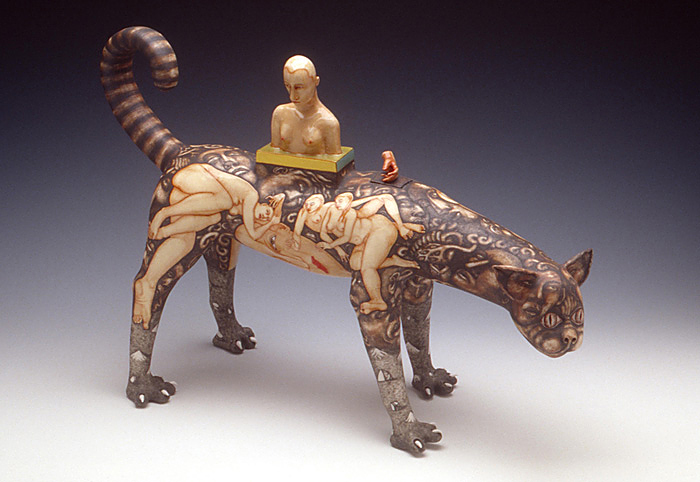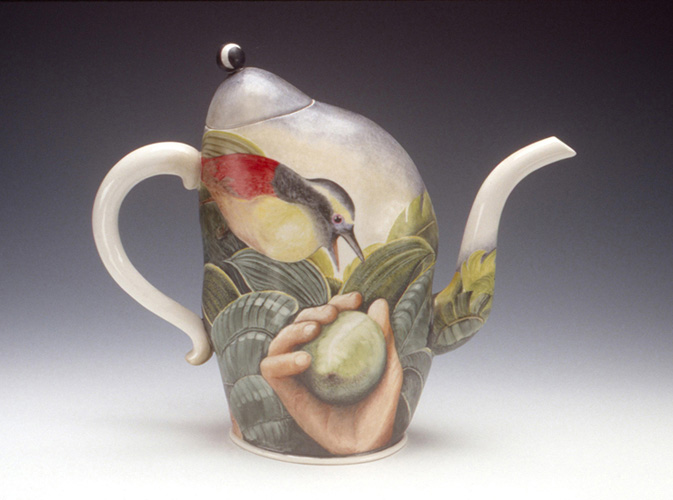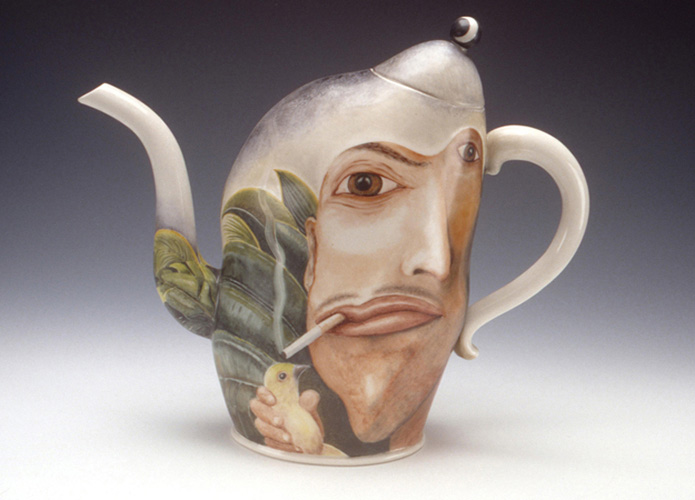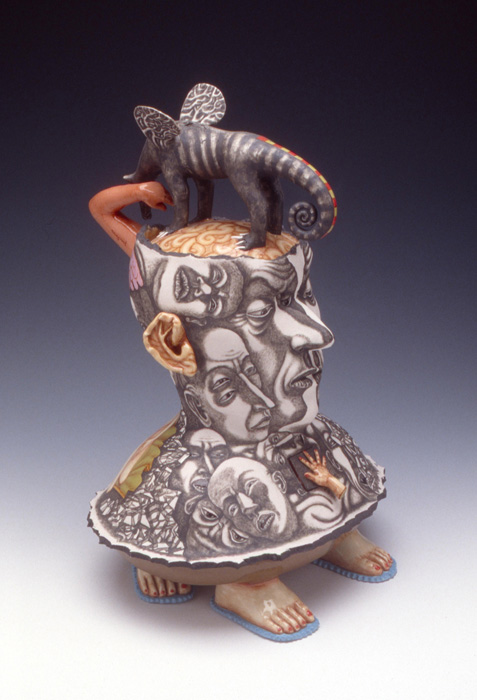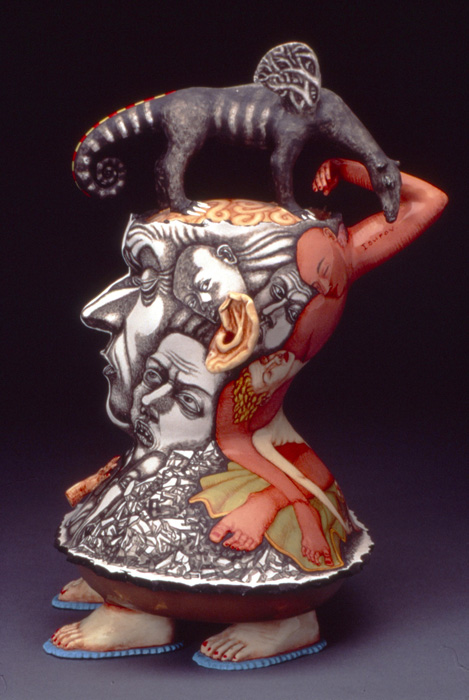For this blog post we will focus on two ceramicists, Kurt Weiser and Sergei Isupov, who are known for covering the surfaces of their designs with drawings. There are many examples of this approach within the Kamm Teapot Collection. Annette Corcoran, Michael Lucero, David Regan, Jason Walker, Akio Takamori, and Red Weldon Sandlin also utilize drawing as a means of embellishment. From bold, quirky, loose, imaginative sketches to highly detailed, restrained, and realistic illustrations, each of these works will, without a doubt, draw you in and capture your imagination.
Kurt Weiser (American, born 1950)
Kurt Weiser is recognized for his dexterity and ingenuity as a potter, draftsman, and china painter. Initially, he created functional stoneware or earthenware pots and abstract porcelain vessels. However, Weiser’s experimentation with china painting in the 1990s changed the nature of his art.[i] His ceramic surfaces began featuring painted and drawn scenes of figures surrounded by lush Eden-like vegetation. These surreal ethereal compositions “…are for the most part just a collection of [Weiser’s] own history of fantasy and view of reality, built the same way we dream.”[ii]
Weiser showed an early interest in art, particularly in ceramics. As a child growing up in Lansing, Michigan, he would frequently unearth “this perfect blue clay” from along country roads in order to experiment with the material.[iii] During high school Weiser’s parents recognized his artistic talent and enrolled him at Michigan’s Interlochen Arts Academy.[iv] At Interlochen, Weiser took a ceramics class and was “seduced by the medium’s tactile qualities as well as the mystery of the process.”[v] Clay continued to be his focus while receiving a B.F.A from the Kansas City Art Institute and a M.F.A. from the University of Michigan, Ann Arbor.[vi] At the Kansas City Art Institute, Weiser had the opportunity to study under acclaimed ceramist Ken Ferguson who mentored and pushed him as an artist. Ferguson recalled years later, “We couldn’t lock [Weiser] out of the building. In fact, his talent and his amazing productivity impressed the faculty, but only served to alienate some of the students. They couldn’t keep up with him…”[vii]
In 1967, after graduate school, Ferguson encouraged Weiser to apply for the Resident Director position at the Archie Bray Foundation and he got the job. The Archie Bray Foundation in Helena, Montana was founded in 1951 with the intention of “[providing] an unstructured and nurturing environment that stimulates creative work in clay.” Past directors, such as Ferguson, Peter Voulkos, and Rudy Autio, had laid a strong foundation for Weiser. Over the next twelve years, he built upon that foundation by expanding the clay business, achieving greater financial stability for the nonprofit, and attracting many prominent resident artists. Weiser’s own work during this period continued to explore functional pottery with special emphasis on raku, salt-fired earthenware, and slip-cast porcelain.
Within the Kamm Teapot Foundation there are some striking Weiser porcelain teapots dating from the 1990s. These vessels reflect a pivotal moment for him creatively. After an inspirational trip to Thailand, Weiser began china painting and combining his life-long love of drawing or sketching with his clay work.[viii] He says it was “out of desperation more than anything else.”[ix] Although drawing on pots was “terribly uncool,” Weiser wanted “to have some say over what happened on the surface.”[x] He worried, however, it might end his career in ceramics.[xi] Instead, this decision “had the opposite effect.”[xii] Weiser was doing something different which made his designs stand out. In the Kamm Collection, his Adam and Eve Teapot, demonstrates this new direction in his work. This upright ovoid structure is skillfully china painted. While a sepia colored Adam and Eve kiss amid a flourishing landscape, a large green-yellow bird set in the foreground is caught capturing a bee. Weiser’s fantastical scene with his careful use of color and exquisite draftsmanship is mesmerizing.
Currently Weiser retains a studio in Tempe, Arizona. He moved there in 1988 after receiving a teaching position at Arizona State University. The university honored him in 1999 by naming him a Regents Professor, their highest honor for faculty members.
SERGEI ISUPOV (RUSSIAN, BORN 1963)
Sergei Isupov also creates fantastical dream-like work. His skillfully-formed, colorful, porcelain sculptures, with their “distortions and re-combinations,” blend the dark and mysterious with a playful child-like quality.[xiii] For Isupov porcelain is a “tool” that allows him to “be an engineer working with [his] hands, a designer, a painter, and a drawer…”[xiv] By “working instinctually and using [his] observations, [he] create[s] a new, intimate universe that reveals the relationships, connections, and contradictions as [he] perceive[s] them…[xv]
Growing up in the Ukraine, Isupov experienced Soviet dominance and his parents, who were both artists, ran a very disciplined household. He recalls that in order to go outside and play his father required the completion of five landscape drawings.[xvi] Today, when discussing his accomplishments in the studio, Isupov credits this regimented background as well as his formal artistic training. He studied at the Ukrainian State Art School in Kiev and received a B.A and M.F.A. in ceramics from the Art Institute of Tallinn in Estonia.[xvii] Before immigrating to the United States in 1994, Isupov had successfully established himself as an artist in Northern Europe and the Baltics. His early work focused on painting and ceramics, particularly the teapot form. However, after settling in America, Isupov transitioned into producing more hand-built sculptural creations.[xviii]
Isupov’s work within the Kamm Teapot Collection captures the essence of his distinctive style. These examples, which easily remind us of Salvador Dalí or René Magritte, are surrealistic, otherworldly, eerie, and dream-like. Figurative in both form and content, Isupov combines animals as well as both male and female individuals.[xix] In examples, such as Invisible Support and Past Day, the surfaces of the clay are covered with drawings. Some sections feature bright crisp colors while others are dramatically monochromatic. For Isupov, “the form of the object gives [him] an idea of what’s supposed to be there. It’s autobiographical, but it’s how [he] observe[s] this life. The works should be on fire with this energy.”[xx]
Isupov continues to work from his studio in Massachusetts. He had a solo exhibition this past summer at the Museum of Russian Art in Minneapolis and examples of his work are currently on view in a traveling show called About Face: Contemporary Ceramic Sculpture.
Further Reading/Viewing:
Burkett, Richard. Masters: Porcelain, Major Works by Leading Ceramists. New York, NY: Lark Books, 2008.
Held, Peter, ed. Eden Revisited: The Ceramic Art of Kurt Weiser. Tempe, AZ: Arizona State University Art Museum, 2007.
Kurt Weiser Oral History. Archives of American Art. Nanette L. Laitman Documentation Project for Craft and
Decorative Arts in America. Conducted by Peter Held. 22 May 2006.
McHugh, Brian. Ceramicist Kurt Weiser. 3 May 2012.
Sergei Isupov: Sculpture 1996-2006. Lenox, MA: Ferrin Gallery, 2006.
Sergei Isupov Short Demo. Slow Clay Center. 7 June 2019.
Weiser, Kurt and Christy. Studio Potter Interview Excerpt 1979. 16 August 2017.
Notes:

